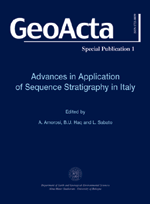GeoActa Special Publication 1
2008


Acquisto online |
GeoActa
an international Journal of Earth Sciences
|
|
Marco Roveri, Rocco Gennari, Silvia Maria Iaccarino, Vinicio Manzi, Francesca Rizzini
Dipartimento di Scienze della Terra, Università di Parma, Parco Area delle Scienze 157/A,43100 Parma, Italy. E-mail: roveri@unipr.it
|
|
Massimo Rossi
Eni-Agip,Division, Via Emilia 1, 20097 San Donato Milanese, Milano, Italy
|
|
|
Alessandro Boscolo Gallo
Dipartimento di Scienze della Terra e Geologico-Ambientali, Università di Bologna, Via Zamboni 67, 40127 Bologna, Italy
|
|
Stefano Lugli
Dipartimento di Scienze della Terra, Università di Modena e Reggio Emilia, Largo S. Eufemia 1, 41100 Modena, Italy
|
|
Alessandra Negri
Dipartimento di Scienze del Mare, Università Politecnica delle Marche, Via delle Brecce Bianche, 60131 Ancona, Italy;
|
|
Marco Taviani
ISMAR-Marine Geology Division, CNR Bologna, Via Gobetti 101, 40129 Bologna, Italy
|
|
|
|
The Adriatic foreland record of Messinian events (Central Adriatic Sea, Italy)
|
|
|
|
|
|
|
|
PDF (2643 KB)
|
Abstract
Commercial wells and seismic data made available by Eni-Agip and their integration with the sedimentary successions cropping out along the steep sea-cliffs of the Gabicce and Conero Riviera allow to extend the geologic-stratigraphic model proposed in the last years for the Messinian inner and central depozones of the Apennine foredeep system to outer foredeep and foreland ramp settings. Primary autochthonous evaporites, consisting of thick-bedded, cyclically stacked selenites have been recognized in the subsurface of the present-day Adriatic offshore in narrow, semi-closed, Late Miocene basins, formed in an extensional regime within the foreland ramp. Evaporites are cut by an erosional surface characterized by a strong seismic reflector, corresponding to the widespread intra-Messinian unconformity (MES) that can be traced basinward into a correlative conformity at the base of a resedimented evaporites complex observed in outcropping successions, where pre-evaporitic deposits have a deep-water character. Similarly to the inner and central foredeep areas, post-evaporitic deposits above the MES can be split in two units separated by a minor unconformity. The Miocene/Pliocene boundary consists of a sharp transition to relatively deep-marine deposits; a notable exception occurs in the Conero Riviera, where this boundary is characterized by a biocalcarenitic lithosome (Trave calcarenites) with a thoroughly bioturbated and reddish horizon at top, here interpreted as a firmground, directly overlain by Lower Pliocene (MPl3 biozone) clays and thin-bedded turbiditic sandstones. This suggests a Late Messinian embryonic growth of the Mt. Conero structure as an intrabasinal high related to the compressional reactivation of former extensional faults. The observed erosional features associated to the MES (canyons, gullies, slump scars) probably formed in sub-aqueous settings over a prolonged time interval encompassing a large part of the Early Pliocene. During this period the almost sediment-starved foreland ramp acted as a transfer zone for small-volume gravity flows feeding the main foredeep from minor lateral sediment sources.
Keywords: Messinian salinity crisis, Northern Apennines, Foreland basins
|
|
|


